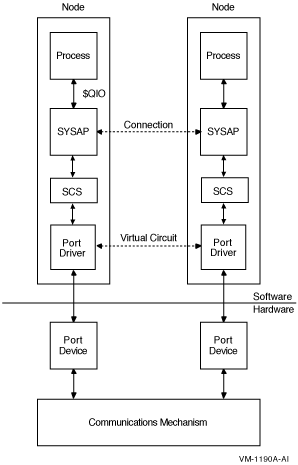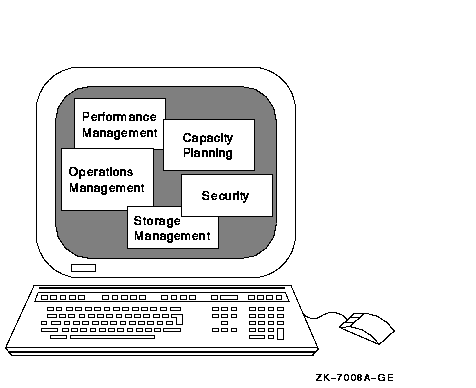| Previous | Contents | Index |
The OpenVMS operating system, which runs on each node in an OpenVMS Cluster, includes several software components that facilitate resource sharing and dynamic adjustments to changes in the underlying hardware configuration.
If one computer becomes unavailable, the OpenVMS Cluster system continues operating because OpenVMS is still running on the remaining computers.
1.3.1 OpenVMS Cluster Software Functions
The following table describes the software components and their main
function.
| Component | Facilitates | Function |
|---|---|---|
| Connection manager | Member integrity | Coordinates participation of computers in the cluster and maintains cluster integrity when computers join or leave the cluster. |
| Distributed lock manager | Resource synchronization | Synchronizes operations of the distributed file system, job controller, device allocation, and other cluster facilities. If an OpenVMS Cluster computer shuts down, all locks that it holds are released so that processing can continue on the remaining computers. |
| Distributed file system | Resource sharing | Allows all computers to share access to mass storage and file records, regardless of the type of storage device (DSA, RF, SCSI, and solid state subsystem) or its location. |
| Distributed job controller | Queuing | Makes generic and execution queues available across the cluster. |
| MSCP server | Disk serving | Implements the proprietary mass storage control protocol in order to make disks available to all nodes that do not have direct access to those disks. |
| TMSCP server | Tape serving | Implements the proprietary tape mass storage control protocol in order to make tape drives available to all nodes that do not have direct access to those tape drives. |
The System Communications Architecture (SCA) defines the communications mechanisms that allow nodes in an OpenVMS Cluster system to co-operate. SCA governs the sharing of data between resources at the nodes and binds together System Applications (SYSAPs) that run on different Integrity server systems and Alpha computers.
SCA consists of the following hierarchy of components:
| Communications Software | Function |
|---|---|
| System applications (SYSAPs) | Consists of clusterwide applications (for example, disk and tape class drivers, connection manager, and MSCP server) that use SCS software for interprocessor communication. |
| System Communications Services (SCS) | Provides basic connection management and communication services, implemented as a logical path between system applications (SYSAPs) on nodes in an OpenVMS Cluster system. |
| Port drivers | Control the communication paths between local and remote ports. |
| Physical interconnects | Consists of ports or adapters for CI, DSSI, Ethernet, ATM, FDDI, and MEMORY CHANNEL interconnects. PEDRIVER is the port driver for LAN (Ethernet) interconnect and starting with OpenVMS Version 8.4 PEDRIVER is also enabled to use TCP/IP for cluster communication. |
1.4.1 System Communications
Figure 1-1 shows the relationship between OpenVMS Cluster components.
Figure 1-1 OpenVMS Cluster System Communications

In Figure 1-1, processes in different nodes exchange information with each other.
Applications running on OpenVMS Cluster systems use TCP/IP, DECnet, or ICC for application communication.
ICC allows processes to efficiently exchange messages with processes running on other cluster members using system communications services and the underlying cluster interconnect. The DECnet and TCP/IP communication services allow processes to locate or start remote servers and then exchange messages.
The generic references to DECnet in this document mean either DECnet for OpenVMS or DECnet-Plus (formerly known as DECnet/OSI) software. |
DECnet provides a feature known as a cluster alias. A cluster alias is a collective name for the nodes in an OpenVMS Cluster system.
Application software can use the cluster alias as the name to connect
to a node in the OpenVMS Cluster. DECnet chooses the node to which the
application makes a connection. The use of a cluster alias frees the
application from keeping track of individual nodes in the OpenVMS
Cluster system and results in design simplification, configuration
flexibility, and application availability. It also provides a mechanism
for load balancing by distributing incoming connections across the
nodes comprising the cluster.
1.4.4 failSAFE IP
TCP/IP provides a feature known as a failSAFE IP that allows IP
addresses to failover when interfaces cease functioning on a system,
where multiple interfaces have been configured with the same IP address.
You can configure a standby failover target IP address that failSAFE IP
assigns to multiple interfaces on a node or across the OpenVMS Cluster
system. When, for example, a Network Interface Controller fails or a
cable breaks or disconnects, failSAFE IP activates the standby IP
address so that an alternate interface can take over to maintain the
network connection. If an address is not preconfigured with a standby,
then failSAFE IP removes the address from the failed interface until it
recovers. When the failed interface recovers, failSAFE IP detects this
and can return its IP address.
1.5 System Management
The OpenVMS Cluster system manager must manage multiple users and
resources for maximum productivity and efficiency while maintaining the
necessary security.
1.5.1 Ease of Management
An OpenVMS Cluster system is easily managed because the multiple members, hardware, and software are designed to co-operate as a single system:
Figure 1-2 illustrates centralized system management.
Figure 1-2 Single-Point OpenVMS Cluster System Management

The OpenVMS operating system supports a number of utilities and tools to assist you with the management of the distributed resources in OpenVMS Cluster configurations. Proper management is essential to ensure the availability and performance of OpenVMS Cluster configurations.
OpenVMS and its partners offer a wide selection of tools to meet diverse system management needs. Table 1-2 describes the HP products available for cluster management and indicates whether each is supplied with the operating system or is an optional product, which is purchased separately. For information about OpenVMS Partners and the tools they provide, see the OpenVMS System Management website:
http://h71000.www7.hp.com/openvms/system_management.html
| Tool | Supplied or Optional | Function |
|---|---|---|
| Accounting | ||
| VMS Accounting | Supplied | Tracks how resources are being used. |
| Configuration and capacity planning | ||
| LMF (License Management Facility) | Supplied | Helps the system manager determine which software products are licensed and installed on a standalone system and on each computer in an OpenVMS Cluster system. |
| SYSGEN (System Generation) utility | Supplied | Allows you to tailor your system for a specific hardware and software configuration. Use SYSGEN to modify system parameters, load device drivers, and create additional page and swap files. |
| CLUSTER_CONFIG.COM | Supplied | Automates the configuration or reconfiguration of an OpenVMS Cluster system and assumes the use of DECnet. |
| CLUSTER_CONFIG_LAN.COM | Supplied | Automates configuration or reconfiguration of an OpenVMS Cluster system without the use of DECnet. |
| HP Management Agents for OpenVMS | Supplied | Consists of a web server for system management with management agents that allow you to look at devices on your OpenVMS systems. |
| HP Insight Manager XE | Supplied with every HP NT server | Centralizes system management in one system to reduce cost, improve operational efficiency and effectiveness, and minimize system down time. You can use HP Insight Manager XE on an NT server to monitor every system in an OpenVMS Cluster system. In a configuration of heterogeneous HP systems, you can use HP Insight Manager XE on an NT server to monitor all systems. |
| Event and fault tolerance | ||
| OPCOM message routing | Supplied | Provides event notification. |
| Operations management | ||
| Clusterwide process services | Supplied | Allows OpenVMS system management commands, such as SHOW USERS, SHOW SYSTEM, and STOP/ID=, to operate clusterwide. |
| Availability Manager | Supplied | From either an OpenVMS system or a Windows node, enables you to monitor one or more OpenVMS nodes on an extended LAN or wide area network (WAN). That is, the nodes for which you are collecting the information must be in the same extended LAN and there should be an interface that communicates with the collector nodes as well as the WAN analyzer. The Availability Manager collects system and process data from multiple OpenVMS nodes simultaneously, and then analyzes the data and displays the output using a native Java GUI. |
| HP WBEM Services for OpenVMS | Supplied | WBEM (Web-Based Enterprise Management) enables management applications to retrieve system information and request system operations wherever and whenever required. It allows customers to manage their systems consistently across multiple platforms and operating systems, providing integrated solutions that optimize your infrastructure for greater operational efficiency. |
| SCACP (Systems Communications Architecture Control Program) | Supplied | Enables you to monitor, manage, and diagnose cluster communications and cluster interconnects. |
| DNS (Distributed Name Service) | Optional | Configures certain network nodes as name servers that associate objects with network names. |
| LATCP (Local Area Transport Control Program) | Supplied | Provides the function to control and obtain information from LAT port driver. |
| LANCP (LAN Control Program) | Supplied | Allows the system manager to configure and control the LAN software on OpenVMS systems. |
| NCP (Network Control Protocol) utility | Optional | Allows the system manager to supply and access information about the DECnet for OpenVMS (Phase IV) network from a configuration database. |
| NCL (Network Control Language) utility | Optional | Allows the system manager to supply and access information about the DECnet--Plus network from a configuration database. |
| POLYCENTER Software Installation Utility (PCSI) | Supplied | Provides rapid installations of software products. |
| Queue Manager | Supplied | Uses OpenVMS Cluster generic and execution queues to feed node-specific queues across the cluster. |
| Show Cluster utility | Supplied | Monitors activity and performance in an OpenVMS Cluster configuration, then collects and sends information about that activity to a terminal or other output device. |
| SDA (System Dump Analyzer) | Supplied | Allows you to inspect the contents of memory saved in the dump taken at crash time or as it exists in a running system. You can use SDA interactively or in batch mode. |
| SYSMAN (System Management utility) | Supplied | Enables device and processor control commands to take effect across an OpenVMS Cluster. |
| VMSINSTAL | Supplied | Provides software installations. |
| Performance | ||
| AUTOGEN utility | Supplied | Optimizes system parameter settings based on usage. |
| Monitor utility | Supplied | Provides basic performance data. |
| Security | ||
| Authorize utility | Supplied | Modifies user account profiles. |
| SET ACL command | Supplied | Sets complex protection on many system objects. |
| SET AUDIT command | Supplied | Facilitates tracking of sensitive system objects. |
| Storage management | ||
| Backup utility | Supplied | Allows OpenVMS Cluster system managers to create backup copies of files and directories from storage media and then restore them. This utility can be used on one node to back up data stored on disks throughout the OpenVMS Cluster system. |
| Mount utility | Supplied | Enables a disk or tape volume for processing by one computer, a subset of OpenVMS Cluster computers, or all OpenVMS Cluster computers. |
| Volume Shadowing for OpenVMS | Optional | Replicates disk data across multiple disks to help OpenVMS Cluster systems survive disk failures. |
OpenVMS Partners offer a wide selection of tools to meet diverse system management needs. The types of tools are described in the following list:
For information about OpenVMS Partners and the tools they provide, see the OpenVMS System Management website:
http://h71000.www7.hp.com/openvms/system_management.html |
In addition to these utilities and partner products, several commands are available that allow the system manager to set parameters on Fibre Channel, SCSI and SAS storage subsystems to help configure and manage the system. See the appropriate hardware documentation for more information.
| Previous | Next | Contents | Index |